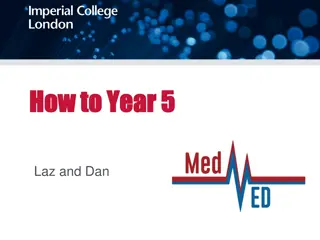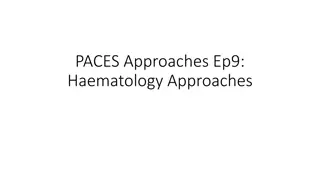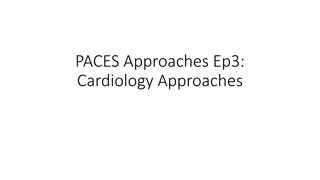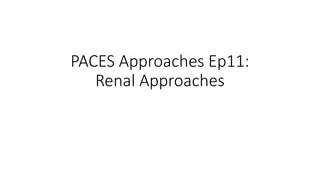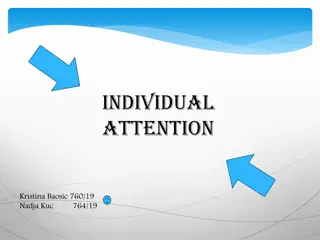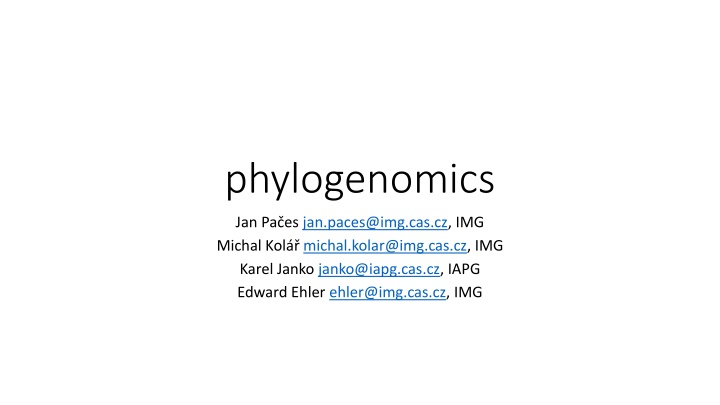
Understanding Phylogenomics and Phylogenetic Analysis
Explore the significance of phylogenetics, its applications in deducing relationships among species or genes, identifying genes undergoing selection, tracing trait evolution, and estimating historical timelines. Learn about the basic assumptions, terminology, tree representations, and testing topologies in phylogenomics.
Download Presentation

Please find below an Image/Link to download the presentation.
The content on the website is provided AS IS for your information and personal use only. It may not be sold, licensed, or shared on other websites without obtaining consent from the author. If you encounter any issues during the download, it is possible that the publisher has removed the file from their server.
You are allowed to download the files provided on this website for personal or commercial use, subject to the condition that they are used lawfully. All files are the property of their respective owners.
The content on the website is provided AS IS for your information and personal use only. It may not be sold, licensed, or shared on other websites without obtaining consent from the author.
E N D
Presentation Transcript
phylogenomics Jan Pa es jan.paces@img.cas.cz, IMG Michal Kol michal.kolar@img.cas.cz, IMG Karel Janko janko@iapg.cas.cz, IAPG Edward Ehler ehler@img.cas.cz, IMG
Phylogenetic analysis Darwin, 1837 Shows evolutionary relations between sequences.
What is phylogenetics good for? Deduce relatioships among species or genes Identify genes undergoing negative (or positive) selection Explore the evolution of traits through history Estimate the timing of historical events
initial assumptions There are three basic assumptions in cladistics: Any group of organisms is related by descent from a common ancestor (fundamental tenet of evolutionary theory). There is a bifurcating pattem of cladogenesis. (This assumption is controversial.) Change in characteristics occurs in lineages over time. This is a necessary condition for cladistics to work.
terminology Nodes External, a.k.a tips Internal, a.k.a hypothetical ancestors Branches Topology of the tree bifurcations aditive tree ultrametric tree root of the tree oldest point true tree derived tree
example ( ( ( ( polyA_26:0.042779, HERV17_27:0.049179 ):0.008643, polyA_410:0.045034 ):0.001912, ( ( polyA_20:0.039953, HERV17_15:0.034230 ):0.003074, HERV17_76:0.041414 ):0.002812 ):0.001440, polyA_30:0.042838, ( polyA_99:0.052972, HERV17_19:0.041888 ):0.003257 )
Alternative representation of trees Blue arrow: genetic distance; Red arrow: meaningless, only for visualization
methods algorithmical methods: Fast giving one result, but not everytime the best one (local optimum) optimalization methods: slower, but can found global maximum gives often range of the best results
methods Requirement for input data: Alignment only of homologous parts Skip gaps (trees, based on other data: restriction analysis or unique insertions or deletions)
algorhitmical (distant) methods Input: matrix of distances UGPMA (Unweighted pair group method with arithmetic averages) WGPMA (Weighted ) Minimal evolution (e.g. Neighbour-joining)
neighbour-joining Star decomposition method
substitutional models DNA: Single parametric: Jukes-Cantor Two parametric: Kimura Transition: purin - purin Transversion: pyrimidin - purin For proteins: Substitution matrix (BLOSUM etc.)
matrix of distances 9 polyA_26 polyA_30 0.1102 polyA_20 0.1144 0.1027 polyA_99 0.1326 0.1100 0.1237 polyA_410 0.1089 0.1009 0.1067 0.1150 HERV17_27 0.1070 0.1263 0.1285 0.1504 0.1198 HERV17_76 0.0960 0.1024 0.0953 0.1221 0.1036 0.1188 HERV17_19 0.1045 0.0994 0.1019 0.1097 0.1059 0.1304 0.0975 HERV17_15 0.0980 0.0975 0.0841 0.1170 0.0977 0.1127 0.0860 0.0927
optimalisation methods Method: search for optimal tree Input: multiple alignment Maximum parsimony Minimises number of mutational steps Maximum likelihood ML Statistical likelihood of alternative trees Explicit model of substitution Bayesian methods Like ML with prior knowledge
parsimony A C A: TATGTTC B: TATTTTC C: TACGTAC D: GACTTAA B D A B C D A C D B
parsimony - step 1 A C A: TATGTTC B: TATTTTC C: TACGTAC D: GACTTAA 1 B D A B 1 C D A C 1 D B
parsimony - step 2 A C A: TATGTTC B: TATTTTC C: TACGTAC D: GACTTAA 1 + 1 B D A B 1 + 2 C D A C 1 + 2 D B
parsimony - step 3 A C A: TATGTTC B: TATTTTC C: TACGTAC D: GACTTAA 2 + 2 B D A B 3 + 1 C D A C 3 + 2 D B
parsimony - step 4 A C A: TATGTTC B: TATTTTC C: TACGTAC D: GACTTAA 4 + 1 B D A B 4 + 2 C D A C 5 + 2 D B
parsimony - step 5 A C A: TATGTTC B: TATTTTC C: TACGTAC D: GACTTAA 5 + 1 B D A B 6 + 1 C D A C 7 + 1 D B
parsimony - result A C A: TATGTTC B: TATTTTC C: TACGTAC D: GACTTAA 6 B D A B 7 C D A C 8 D B
optimalisation methods Parsimony does not count length of branches and probabilities of individual changes. Maximum likelihood choose the trees, where less probable events are on longer branches.
differencies DISTANCE, PARSIMONY, AND MAXIMUM LIKELIHOOD Distance matrix methods simply count the number of differences between two sequences. This number is referred to as the evolutionary distance, and its exact size depends on the evolutionary model used. The principle of maximum parsimony searches for a tree that requires the smallest number of changes to explain the differences observed among the taxa under study. A maximum-likelihood approach to phylogenetic inference evaluates the probability that the chosen evolutionary model has generated the observed data.
topology testing Bootstrap: selection without repeat Jack Knife: selection without repeat, but shorter sequences or lower number. Bayesian methods Approximate likelihood ratio test (aLRT)
root of the tree Root indicates direction of the evolution Most recent common ancestor MRCA Midpoint rooting Assume constant evolutionary rate Outgroup rooting Outgroup is node known to have diverged earliest
Monophyletic group A.k.a clade Share a more recent common ancestor within the group than outside the group
Test: understanding the tree Which is true? A) mouse is more closely related to fish than frog is to fish B) lizard is more closely related to fish than mouse is to fish C) human and frog are equally related to fish
Additional concepts is phylogenetics Gene duplication Recombination Horizontal gene transfer Coevolution Gene conversion Codon bias Hypermutable sites
programs http://geta.life.uiuc.edu/~nikos/LINKS/ biocomputing_servers.html http://bioweb.pasteur.fr/seqanal/ phylogeny/phylip-uk.html http://evolution.genetics.washington.edu/ phylip/software.html


